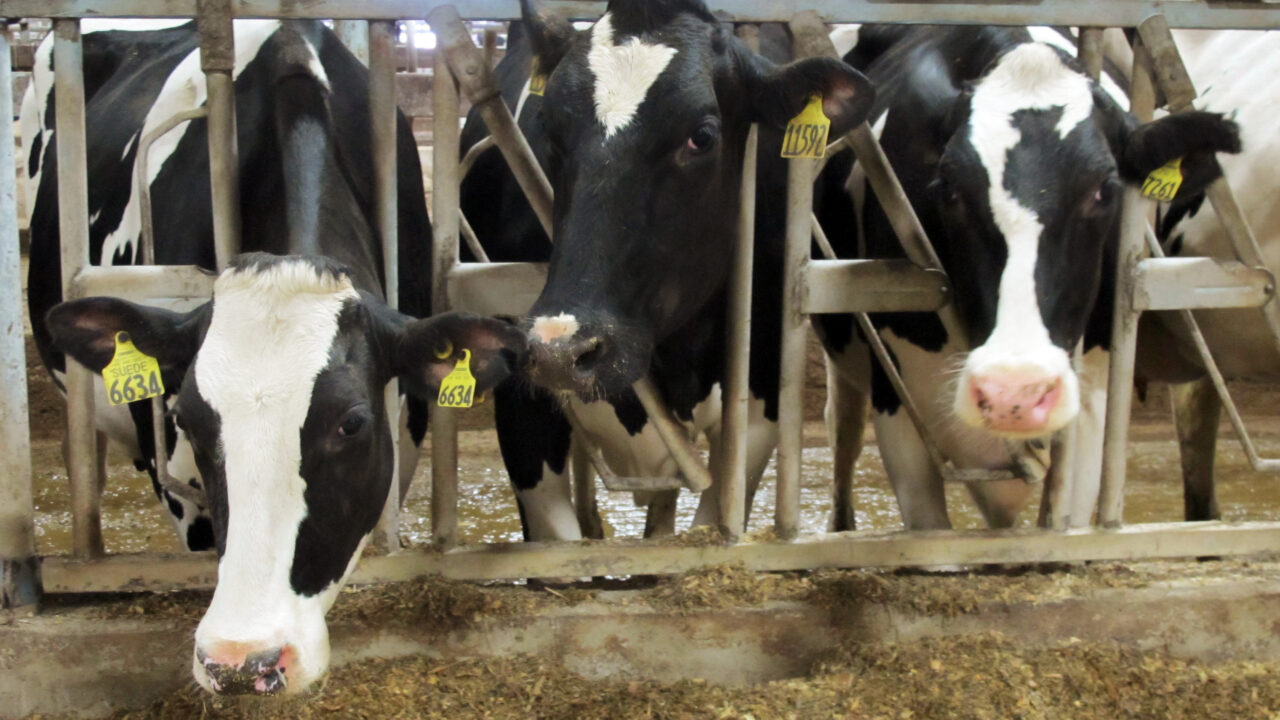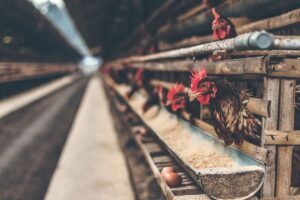The Fallacy of ‘Climate Friendly’ Beef
Despite industry claims, the evidence suggests industrial-scale cattle farming will always hurt the planet. Three Holsteins cows at Larson Acres Inc. in Magnolia, Wis. (AP Photo/Dinesh Ramde)
Three Holsteins cows at Larson Acres Inc. in Magnolia, Wis. (AP Photo/Dinesh Ramde)
When it comes to taking the blame for climate change, the energy sector absorbs most of the heat. But more and more, the public is learning about animal agriculture’s substantial role. The raising of animals for slaughter produces 14.5% of global greenhouse gas emissions, approaching half of the energy sector’s 34%. One species in particular looms large in this picture: Around 10% of all global greenhouse gas emissions are produced by the cattle industry.
As awareness grows around the eco-impact of raising cows for meat, the beef industry has been working hard to maintain public confidence. At the center of its efforts is a push to sell consumers on the idea of “climate friendly” or “low-carbon” beef. Tyson’s new Brazen Beef is advertised as a “climate smart” innovation; while the banner of “regenerative beef” — claimed to actually benefit the land — has been taken up by McDonald’s and Walmart.
But what do these buzzwords actually mean? Can beef ever be “climate friendly”?
Tyson Foods is one of the largest meat processing companies in the world. In recent years, it has found itself under pressure to cut eco-impacts and improve its sustainability efforts. It has responded with the introduction of Brazen Beef, which uses cattle “enrolled in Tyson Foods’ Climate-Smart Beef Program for emission reduction from pasture to production,” according to the product’s website. The baseline and metrics needed to measure this 10% reduction, however, is far from clear. “There’s no way that the math even works out,” says Jan Dutkiewicz, a political economist who studies the agriculture industry.
Decreased consumption rarely appears in the discourse around regenerative agriculture.
Together with New York University environmental scientist Matthew Hayek, Dutkiewicz took a deep dive into Tyson’s low-carbon claims for The New Republic. “It’s nearly impossible to confirm such a marginally small reduction in emissions in one specific product,” they concluded. “Tyson sources its beef from across a wide range of farms; production methods among farms vary widely, with one study showing a 30% variation in carbon emissions between three commonly used beef-rearing methods in the Midwest.” Moreover, they write, no one can seem to find any evidence behind Tyson’s emissions reduction claims.
In an investigation for Vox, Kenny Torrella reached a similar conclusion. “Tyson’s climate-friendly beef website is full of earnest marketing phrases like this one: ‘If we’re showing up for the climate, then we’ve got to show our work.’ Yet that ‘work’ is nowhere to be found,” he noted.
Tyson told the Progressive Grocer that the company is “trying to be upbeat and different” with a campaign that speaks definitively to younger millennial and Gen Z consumers, the market sector most concerned with the impacts of climate change. The Brazen Beef website is packed with imagery of young adults being active, social and happy.
Launching products like Brazen Beef, says Dutkiewicz, is largely about landing some good press — without much fear of being called to account. “The average food consumer doesn’t spend time studying food,” he says.
Proponents of regenerative beef, or meat from cattle engaged in “holistic grazing,” are also banking on positive press and science-illiterate consumers. Since the release of the documentary “Kiss the Ground” in 2020, some have proposed the integration of livestock into regenerative agriculture ideas as a silver bullet in the fight against climate change. They promote regenerative beef as sustainable because it employs farming practices that improve soil through pasture rotation and increased organic matter (manure), while also capturing some carbon through trampling and the use of deeper root systems than those found in conventional feed cropping systems.
Critics, however, allege that the negative impacts of regenerative beef outweigh the benefits.
“There is no grass-fed or regenerative [cattle] farm that is net storing more carbon than they are emitting [in] methane,” says ecologist Nicholas Carter. Methane, another type of GHG, is often omitted from claims about carbon drawdown, he notes, even though it has higher global warming potential than carbon dioxide over a shorter time frame, according to the Intergovernmental Panel on Climate Change.
“If you want to improve soil, draw down carbon and bring back biodiversity. The solution is to re-wild.”
Land use is also already a major concern when it comes to beef production, making the scalability of regenerative agriculture difficult to conceive. Cattle farming occupies 41% of all land in the U.S., even though 99% of livestock are raised on factory farms. Over 40 million cattle and calves are slaughtered for food annually in the U.S. Transitioning that number of cows to eating grass, says Carter, would require 270% more land. Making regenerative beef viable as a climate-friendly solution would also require significant reduction in overall beef consumption. Decreased consumption, however, rarely appears in the discourse around regenerative agriculture.
“Any shift to regenerative agriculture without a major reduction in animal source foods will continue to take away from wild ecosystems,” says Carter. “What the regenerative agriculture movement always misses is that you can store [up to] 75% more soil organic carbon in wild ecosystems. If you want to improve soil, draw down carbon and bring back biodiversity. The solution is to re-wild.”
Re-wilding is the practice of restoring natural habitats ravaged by animal farming by reintroducing native flora and fauna, including native ruminants such as bison. “Cattle can be considered an invasive species,” says senior food campaigner for the Center for Biological Diversity, Jennifer Molidor. Where regenerative ranchers attempt to minimize impacts with rotational patterns and smaller grazing herds, “they fall far short of promoting biodiversity compared to native animals, and more often than not have severe impacts on soil health, water quality and make a monumental contribution to accelerating climate change.”
Improving ecosystem integrity is an important part of re-wilding, Molidor explains. It’s also one, she says, “many food producers overlook or misunderstand when attempting to farm in better harmony with the land.” Re-wilding “can heal soil that has been harmed by agricultural degradation and pollution and restore native habitat and improve wildlife connectivity.” But that process is fundamentally incompatible with the cattle industry in its current size and form. Concludes Molidor, “The more cattle we produce, the more the land suffers.”
Your support matters…Independent journalism is under threat and overshadowed by heavily funded mainstream media.
You can help level the playing field. Become a member.
Your tax-deductible contribution keeps us digging beneath the headlines to give you thought-provoking, investigative reporting and analysis that unearths what's really happening- without compromise.
Give today to support our courageous, independent journalists.



My comment appears to have been censored. “….the vested interests will (kill) to protect.”
Are there really that many beef animals producing emissions of concern? Pre contact North America, let alone the rest of the non industrialized world, had bison herds in the millions, as well as antelope, elk, deer and caribou all of whom did their part to fertilize the prairies and forests. Africa was just as abundant. Industry is THE culprit no one can hold accountable because of the massive global treasure pile the vested interests will...
Are there really that many beef animals producing emissions of concern? Pre contact North America, let alone the rest of the non industrialized world, had bison herds in the millions, as well as antelope, elk, deer and caribou all of whom did their part to fertilize the prairies and forests. Africa was just as abundant. Industry is THE culprit no one can hold accountable because of the massive global treasure pile the vested interests will kill to preserve. Right, blame it on a cow. We’ll believe any narrative it seems.